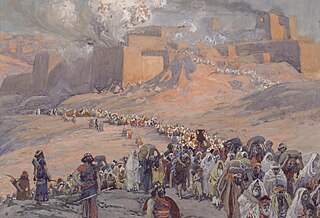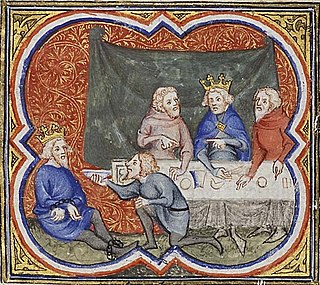
The history of ancient Israel and Judah covers the history of the Israelite tribes from their appearance in new villages in the hill country of Canaan, through the existence of the kingdoms of Israel in the north and Judah in the south, and up to the demise of those kingdoms at the hands of the Mesopotamian empires. It plays out in Southern Levant during the Iron Age. The earliest known reference to "Israel" as a people or tribal confederation is in the Merneptah Stele, an inscription from ancient Egypt that dates to about 1208 BCE. According to modern archaeology, ancient Israelite culture developed as an outgrowth from the preexisting Canaanite civilization. Two related Israelite polities known as the Kingdom of Israel and the Kingdom of Judah had emerged in the region by Iron Age II.

The Kingdom of Judah was an Israelite kingdom of the Southern Levant during the Iron Age. Centered in the highlands of Judea, the landlocked kingdom's capital was Jerusalem. Jews are named after Judah and are primarily descended from it.

The Babylonian captivity or Babylonian exile is the period in Jewish history during which a large number of Judeans from the ancient Kingdom of Judah were captives in Babylon, the capital city of the Neo-Babylonian Empire, following their defeat in the Jewish–Babylonian War and the destruction of Solomon's Temple in Jerusalem. The event is known to be historical, and is described in archaeological and extra-biblical sources, in addition to the Hebrew Bible.

According to the Hebrew Bible, the tribe of Judah was one of the twelve Tribes of Israel, named after Judah, the son of Jacob. Judah was the first tribe to take its place in the Land of Israel, occupying the southern part of the territory. Jesse and his sons, including King David, belonged to this tribe.
Sippar was an ancient Near Eastern Sumerian and later Babylonian city on the east bank of the Euphrates river. Its tell is located at the site of modern Tell Abu Habbah near Yusufiyah in Iraq's Baghdad Governorate, some 69 km (43 mi) north of Babylon and 30 km (19 mi) southwest of Baghdad. The city's ancient name, Sippar, could also refer to its sister city, Sippar-Amnanum ; a more specific designation for the city here referred to as Sippar was Sippar-Yahrurum.

The Kassites were people of the ancient Near East, who controlled Babylonia after the fall of the Old Babylonian Empire c. 1531 BC and until c. 1155 BC.

Jewish history is the history of the Jews, their nation, religion, and culture, as it developed and interacted with other peoples, religions, and cultures.

Jeconiah, also known as Coniah and as Jehoiachin, was the nineteenth and penultimate king of Judah who was dethroned by the King of Babylon, Nebuchadnezzar II in the 6th century BCE and was taken into captivity. He was the son and successor of King Jehoiakim, and the grandson of King Josiah. Most of what is known about Jeconiah is found in the Hebrew Bible. Records of Jeconiah's existence have been found in Iraq, such as the Jehoiachin's Rations Tablets. These tablets were excavated near the Ishtar Gate in Babylon and have been dated to c. 592 BCE. Written in cuneiform, they mention Jeconiah and his five sons as recipients of food rations in Babylon.

Amel-Marduk, also known as Awil-Marduk, or under the biblical rendition of his name, Evil-Merodach, was the third king of the Neo-Babylonian Empire, ruling from 562 BC until his overthrow and murder in 560 BC. He was the successor of Nebuchadnezzar II. On account of the small number of surviving cuneiform sources, little is known of Amel-Marduk's reign and actions as king.

The history of the Jews in Iraq is documented from the time of the Babylonian captivity c. 586 BCE. Iraqi Jews constitute one of the world's oldest and most historically significant Jewish communities.

The Nabonidus Chronicle is an ancient Babylonian text, part of a larger series of Babylonian Chronicles inscribed in cuneiform script on clay tablets. It deals primarily with the reign of Nabonidus, the last king of the Neo-Babylonian Empire, covers the conquest of Babylon by the Persian king Cyrus the Great, and ends with the start of the reign of Cyrus's son Cambyses II, spanning a period from 556 BC to some time after 539 BC. It provides a rare contemporary account of Cyrus's rise to power and is the main source of information on this period; Amélie Kuhrt describes it as "the most reliable and sober [ancient] account of the fall of Babylon."
The Battle of Opis was the last major military engagement between the Achaemenid Persian Empire and the Neo-Babylonian Empire, which took place in September 539 BC, during the Persian invasion of Mesopotamia. At the time, Babylonia was the last major power in Western Asia that was not yet under Persian control. The battle was fought in or near the strategic riverside city of Opis, located north of the capital city of Babylon in modern-day Iraq, and resulted in a decisive victory for Persia. Shortly afterwards, the Babylonian city of Sippar surrendered to Persian forces, who then supposedly entered Babylon without facing any further resistance. The Persian king Cyrus the Great was subsequently proclaimed as the king of Babylonia and its subject territories, thus ending its independence and incorporating the entirety of the fallen Neo-Babylonian Empire into the greater Achaemenid Empire.

The fall of Babylon was the decisive event that marked the total defeat of the Neo-Babylonian Empire to the Achaemenid Persian Empire in 539 BCE.

The return to Zion is an event recorded in Ezra–Nehemiah of the Hebrew Bible, in which the Jews of the Kingdom of Judah—subjugated by the Neo-Babylonian Empire—were freed from the Babylonian captivity following the Persian conquest of Babylon. In 539 BCE, the Persian king Cyrus the Great issued the Edict of Cyrus allowing the Jews to return to Jerusalem and the Land of Judah, which was made a self-governing Jewish province under the new Persian Empire.

Jehoiachin's rations tablets date from the 6th century BC and describe the oil rations set aside for a royal captive identified with Jeconiah, king of Judah. Tablets from the royal archives of Nebuchadnezzar II, emperor of the Neo-Babylonian Empire, were unearthed in the ruins of Babylon that contain food rations paid to captives and craftsmen who lived in and around the city. On one of the tablets, "Ya’u-kīnu, king of the land of Yahudu" is mentioned along with his five sons listed as royal princes.

Yehud Medinata, also called Yehud Medinta or simply Yehud, was an autonomous administrative division of the Achaemenid Persian Empire. It constituted a part of Eber-Nari and was bounded by Arabia to the south, lying along the frontier of the two satrapies. Spanning most of Judea—from the Shephelah in the west to the Dead Sea in the east—it was one of several Persian provinces in Palestine, together with Moab, Ammon, Gilead, Samaria, Ashdod, and Idumea, among others. It existed for just over two centuries before the Greek conquest of Persia resulted in it being incorporated into the Hellenistic empires.
Yehud was a province of the Neo-Babylonian Empire established in the former territories of the Kingdom of Judah, which was destroyed by the Babylonians in the aftermath of the Judahite revolts and the siege of Jerusalem in 587/6 BCE. It first existed as a Jewish administrative division under Gedaliah ben Aḥikam, who was later assassinated by a fellow Jew. The Fast of Gedaliah, a minor fast day in Judaism, was established in memory of this event, and is lamented by observant Jews even to this day.

Judah's revolts against Babylon were attempts by the Kingdom of Judah to escape dominance by the Neo-Babylonian Empire. Resulting in a Babylonian victory and the destruction of the Kingdom of Judah, it marked the beginning of the prolonged hiatus in Jewish self-rule in Judaea until the Maccabean Revolt of the 2nd century BCE. Babylonian forces captured the capital city of Jerusalem and destroyed Solomon's Temple, completing the fall of Judah, an event which marked the beginning of the Babylonian captivity, a period in Jewish history in which a large number of Judeans were forcibly removed from Judah and resettled in Mesopotamia.

2 Kings 24 is the twenty-fourth chapter of the second part of the Books of Kings in the Hebrew Bible or the Second Book of Kings in the Old Testament of the Christian Bible. The book is a compilation of various annals recording the acts of the kings of Israel and Judah by a Deuteronomic compiler in the seventh century BCE, with a supplement added in the sixth century BCE. This chapter records the events during the reigns of Jehoiakim, Jehoiachin and Zedekiah, kings of Judah.

2 Kings 25 is the twenty-fifth and final chapter of the second part of the Books of Kings in the Hebrew Bible or the Second Book of Kings in the Old Testament of the Christian Bible. The book is a compilation of recorded acts of the kings of Israel and Judah by a Deuteronomic compiler in the seventh century BCE; a supplement was added in the sixth century BCE. This chapter records the events during the reign of Zedekiah, the last king of Judah, the fall of Jerusalem, the governorship of Gedaliah, and the release of Jehoiachin from prison in Babylon.
















